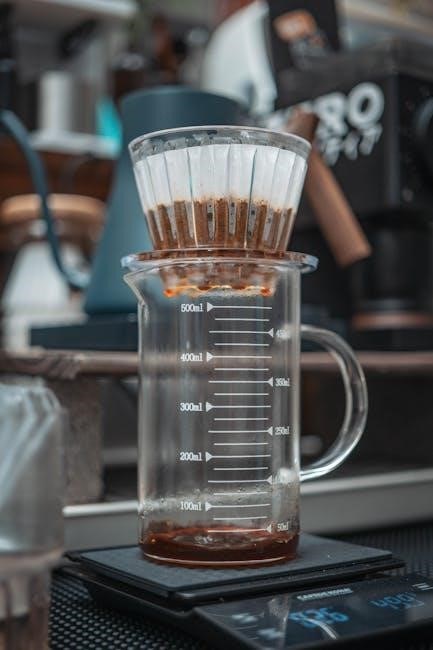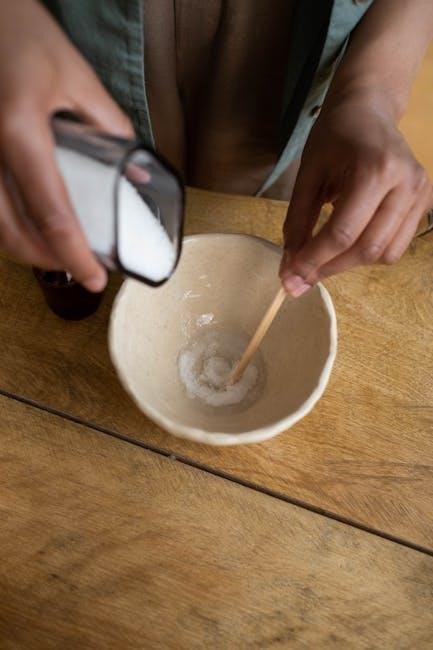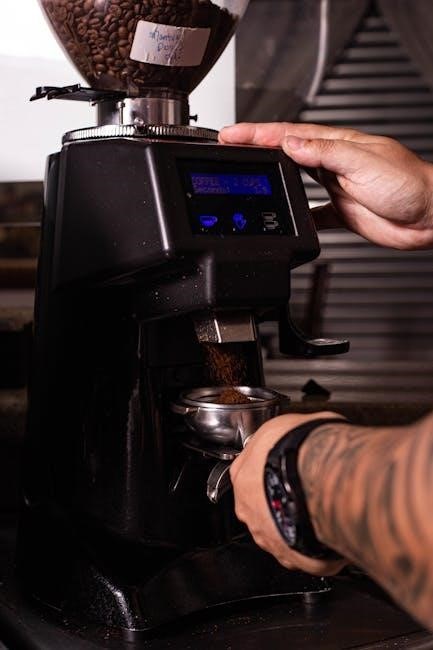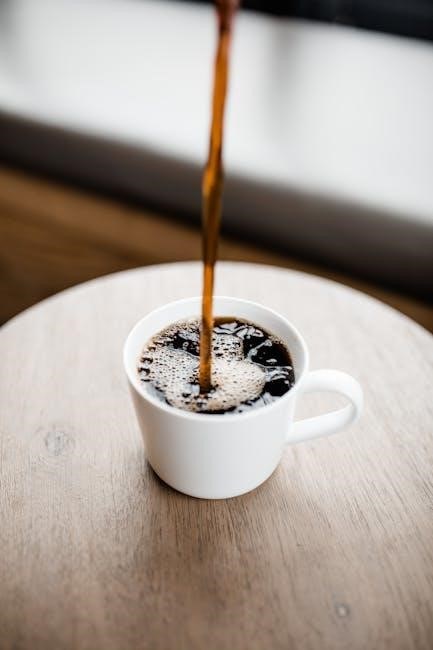Manual pour-over coffee is a method of brewing that involves manually pouring hot water over ground coffee beans in a filter. This technique allows for precise control over the brewing process, resulting in a balanced and flavorful extraction. It emphasizes the connection between the brewer and the coffee, making it a popular choice among coffee enthusiasts seeking an artisanal experience.
What is Manual Pour Over?
Manual pour-over is a brewing method where hot water is manually poured over ground coffee beans in a filter. It requires a dripper, filter, and precise technique, offering control over extraction. This method highlights the coffee’s nuances, resulting in a clean, balanced, and flavorful cup with distinct clarity and brightness.
History and Popularity of Manual Pour Over
Manual pour-over coffee originated in the early 20th century, gaining popularity in Japan and later worldwide. Its resurgence in the 2000s aligns with the third-wave coffee movement, emphasizing high-quality beans and craftsmanship. Today, it’s a staple in specialty cafes and home setups, cherished for its simplicity, flavor clarity, and meditative brewing ritual.

Benefits of Manual Pour Over Brewing
Manual pour-over brewing offers precise control over flavor, cost-effectiveness, and environmental friendliness. It ensures a clean, nuanced extraction without waste, making it a sustainable and rewarding coffee experience.
Control Over Flavor Profile
Manual pour-over brewing allows precise adjustment of variables like water quantity, grind size, and pouring technique, enabling customization of the coffee’s flavor profile. This method lets you tailor brightness, body, and nuance to your preference, ensuring a truly personalized and refined coffee experience without machine constraints.
Cost-Effectiveness
Manual pour-over brewing is a budget-friendly method with minimal equipment costs. The initial investment in a dripper, filter, and grinder is modest, and there are no ongoing expenses beyond coffee beans. This makes it an affordable and sustainable option for coffee lovers seeking quality without the need for expensive machines.
Environmental Impact
Manual pour-over brewing is eco-friendly, as it often uses reusable metal or cloth filters, reducing paper waste. The method requires no electricity, lowering energy consumption. Additionally, the focus on quality over quantity encourages mindful consumption, minimizing excess coffee and grounds, making it a sustainable choice for environmentally conscious coffee drinkers.
Equipment Needed for Manual Pour Over
Manual pour-over brewing requires a coffee dripper, filter papers, a kettle, a coffee grinder, and a scale. These tools ensure precise measurement and optimal extraction for a perfect cup.
Coffee Dripper
A coffee dripper is a cone-shaped device used to hold the filter and ground coffee during brewing. Popular options include the V60, Chemex, and Kalita. Made from materials like glass, ceramic, or metal, it allows for precise control over water flow, ensuring even extraction and a clean cup of coffee.
Filter Papers
Filter papers are essential for manual pour-over brewing, absorbing impurities and oils from the coffee. Available in bleached or unbleached options, they ensure a clean and balanced extraction. Regularly rinsing the filter before use prevents paper taste, enhancing the coffee’s natural flavors and aromas for a smoother brewing experience.
Kettle
A kettle is a crucial tool for manual pour-over brewing, used to heat and pour water evenly over the coffee grounds. A gooseneck kettle is ideal, offering precision control for consistent extraction. Choose a stainless steel or electric kettle with temperature control to ensure optimal water heat for brewing, enhancing flavor quality and extraction balance.
Coffee Grinder
A coffee grinder is essential for manual pour-over, enabling freshly ground beans for optimal flavor. Burr grinders are preferred over blade grinders for consistent grind size. Adjusting the grind ensures proper water flow and extraction. Freshly grinding beans just before brewing preserves aromas and flavors, crucial for a high-quality pour-over experience;
Scale
A digital scale is necessary for precise measurement of coffee and water, ensuring the perfect ratio. It allows for accurate brewing, promoting even extraction and consistent flavor. Using a scale guarantees each brew is balanced, making it an indispensable tool for achieving the best results every time.
Step-by-Step Guide to Manual Pour Over
A step-by-step guide to manual pour over walks you through the process of brewing flavorful coffee with precision and ease, ensuring a perfect balanced extraction every time.
Preparing the Equipment
Start by gathering all necessary tools: a coffee dripper, filter, kettle, grinder, and scale. Rinse the filter with hot water to remove any paper taste. Boil fresh water and measure your coffee beans according to your desired brew strength. Grind the beans to the appropriate consistency and place everything within easy reach for a smooth process.
Measuring Coffee and Water
Measure coffee and water using a scale for precision. A common ratio is 1:16 (one gram of coffee to 16 grams of water). Adjust according to personal preference for strength. Ensure both measurements are accurate to achieve optimal extraction and flavor balance in your pour-over brew.
Blooming the Coffee
Blooming involves adding a small amount of hot water (about 2-3 times the coffee’s weight) to the grounds. Pour in a circular motion to saturate evenly. Allow 30-45 seconds for the coffee to release trapped gases, enhancing flavor and aroma. This step ensures balanced extraction and prevents sourness in the brew.
Pouring Techniques
Pouring techniques are crucial for even extraction. Start with a gentle circular motion to saturate all grounds after blooming. Gradually increase the pour’s speed and coverage, ensuring no dry spots. Pulse pouring toward the end helps reach thicker areas, promoting optimal extraction and a balanced cup of coffee.

Tips for Achieving the Perfect Brew
Use fresh, high-quality coffee beans and filtered water for optimal flavor. Maintain the ideal water temperature and ensure even coffee distribution. Consistency is key to perfecting your technique.
Choosing the Right Coffee Beans
Selecting high-quality, freshly roasted coffee beans is essential for a superior pour-over experience. Opt for beans that suit your flavor preferences, considering factors like origin, roast level, and processing method. Lighter roasts often highlight nuanced flavors, while darker roasts provide bold, rich notes. Store beans in a cool, dark place to preserve freshness.
Water Temperature
The ideal water temperature for manual pour-over brewing is between 195°F and 205°F. Water that’s too hot can burn the coffee, while cooler water may result in under-extraction. Use a thermometer to ensure precision, as consistent temperature control is key to achieving optimal flavor extraction and balance in your brew.
Grind Size
The grind size for manual pour-over coffee should be medium to medium-fine, resembling sand. This ensures proper water flow and extraction. A grind too fine can lead to over-extraction and bitterness, while too coarse may result in under-extraction and a weak cup. Adjusting the grind size is crucial for achieving balanced flavor.
Common Mistakes to Avoid
Common mistakes include using incorrect water temperature, uneven coffee distribution, and insufficient or excessive water. These errors can lead to under-extracted or bitter coffee, ruining the brew. Precision and consistency are key to achieving optimal results.
Incorrect Water Temperature
Using water that’s too hot or cold significantly impacts extraction. The ideal temperature for brewing is between 195°F and 205°F. Water below this range results in under-extraction, while water above can cause over-extraction, leading to a bitter taste. Always use a thermometer for precise control to ensure optimal flavor.
Uneven Coffee Distribution
Uneven coffee distribution leads to inconsistent extraction, affecting the overall flavor. Grounds that are unevenly spread can cause over-extraction in some areas and under-extraction in others, resulting in a bitter or sour taste. Carefully leveling the grounds ensures uniform saturation for a balanced brew.
Insufficient or Excessive Water
Using too little water results in under-extracted, bitter coffee, while too much water causes a weak, over-extracted brew. Maintaining the optimal water-to-coffee ratio ensures balanced extraction. Proper measurement and careful pouring are essential to achieve the desired flavor profile and avoid these common mistakes in manual pour-over brewing.

Manual Pour Over vs. Other Brewing Methods
Manual pour-over stands out for its precision and flavor control, differing from drip brewing, French press, and espresso in its manual process and clean extraction.
Comparison with Drip Brewing
Manual pour-over offers more control over brewing variables like water temperature and coffee-to-water ratio compared to drip brewing, which is automated and less customizable. Pour-over results in a cleaner, more nuanced flavor, while drip brewing is convenient but may lack the precision and flavor depth of manual methods.
Comparison with French Press
Manual pour-over differs from French Press by using a filter, resulting in a cleaner, less oily coffee. French Press steeping involves full immersion, yielding a bolder, heavier-bodied brew. Pour-over offers more control over extraction, while French Press provides a richer, more robust flavor profile, catering to different coffee preferences.
Comparison with Espresso
Manual pour-over and espresso differ significantly in brewing method and result. Pour-over relies on gravity and filters for a cleaner, nuanced coffee, while espresso uses high pressure to force water through finely ground beans, creating a concentrated, rich shot with a thick crema. Espresso is faster but requires specialized equipment.

Health Benefits of Manual Pour Over Coffee
Manual pour-over coffee offers lower acidity, reducing stomach discomfort. It allows for higher caffeine control, catering to individual preferences. The process also minimizes contaminants, promoting a cleaner brew.
Lower Acidity
Manual pour-over coffee typically has lower acidity due to the controlled brewing process. By adjusting water temperature and steeping time, fewer acidic compounds are extracted, resulting in a smoother flavor. This makes it easier on the stomach, ideal for those sensitive to high acidity in their coffee.
Higher Caffeine Control
Manual pour-over brewing offers precise control over caffeine levels. By adjusting steeping time, coffee-to-water ratio, and grind size, you can customize extraction to suit your preference. This method allows for a more balanced caffeine intake, catering to both those seeking a strong boost and those preferring a lighter brew.
Reduced Risk of Contaminants
Manual pour-over brewing minimizes exposure to contaminants due to the use of filter papers, which trap impurities and oils. This method reduces the risk of unwanted substances in your coffee compared to unfiltered methods like French press. Additionally, the ability to use clean, filtered water further enhances the purity of the brew.
Manual pour-over coffee offers a rewarding brewing experience with precise control, rich flavor, and simplicity, making it a beloved method for coffee enthusiasts seeking quality and connection.
Final Thoughts on Manual Pour Over
Manual pour-over coffee is a timeless brewing method that combines simplicity with precision, allowing coffee lovers to connect deeply with their coffee. Its emphasis on quality and customization makes it a rewarding experience for enthusiasts seeking to elevate their daily ritual and savor every sip with intention and joy.
Encouragement to Try Manual Pour Over
Manual pour-over brewing offers a meditative and rewarding way to connect with coffee. It’s easy to start, requires minimal equipment, and allows full control over flavor. Give it a try to experience the joy of crafting your perfect cup and discovering the nuances of your favorite beans with every pour.

